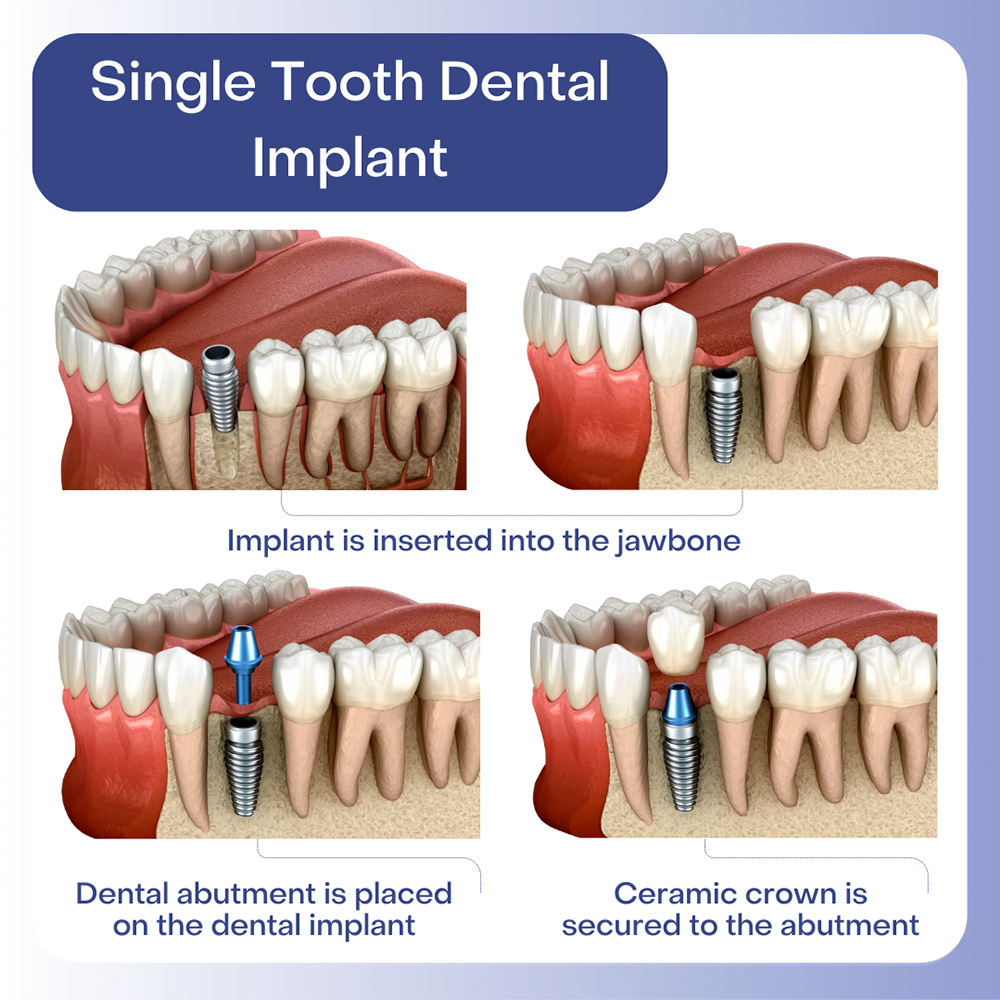The Best Guide To Dental Sense
The Best Guide To Dental Sense
Blog Article
All About Dental Sense
Table of ContentsThe Of Dental SenseDental Sense Fundamentals ExplainedNot known Facts About Dental SenseThe Best Strategy To Use For Dental Sense
are clinical devices surgically dental implanted into the jaw to recover an individual's capacity to chew or their look. They provide support for man-made (phony) teeth, such as crowns, bridges, or dentures. When a tooth is lost because of injury or condition, a person can experience problems such as rapid bone loss, defective speech, or modifications to chewing patterns that cause pain.Oral implant systems include an oral implant body and dental implant abutment and may also consist of an abutment addiction screw. Cosmetic dentistry services. The oral implant body is operatively placed in the jawbone instead of the tooth's origin. The dental implant abutment is typically affixed to the implant body by the abutment fixation screw and expands through gum tissues into the mouth to support the attached man-made teeth
(https://www.edocr.com/v/djpmklwo/matthewmusic33101/dental-sense)Framework of The Oral Implant System picking dental implants, talk with your dental copyright regarding the prospective advantages and dangers, and whether you are a candidate for the treatment. Things to consider: Your overall wellness is a crucial element in figuring out whether you are a great prospect for oral implants, for how long it will certainly take to heal, and how long the dental implant may remain in place.
Smoking cigarettes may impact the healing procedure and decrease the long-lasting success of the dental implant. The healing process for the dental implant body may take several months or longer, throughout which time you commonly have a short-term joint in place of the tooth. the oral implant procedure: Thoroughly adhere to the dental hygiene directions offered to you by your dental service provider.
10 Simple Techniques For Dental Sense
Implant failure can result in the demand for an additional medical procedure to repair or replace the dental implant system. Recovers the capacity to eat Restores cosmetic appearance Helps keep the jawbone from shrinking due to bone loss Preserves the health and wellness of the bordering bone and periodontals Assists keep surrounding (close-by) teeth stable Boosts lifestyle Damages to surrounding natural teeth throughout implant placement Injury to the surrounding cells throughout surgery, such as sinus perforation Injury during surgery (as an example, crack of bordering jawbone) Insufficient function, such as really feeling like the teeth do not bite together typically A sensation that the tooth is loose or twisting in place resulting from an abutment screw loosening Implant body failing (looseness of the dental implant body) because of systemic infection, which might be more likely in clients with uncontrolled diabetics issues because of neighborhood infection in bone and gum tissues supporting the implant body due to postponed healing, which may be more probable in people that smoke Difficulty cleaning the gum tissues around the dental implant, resulting in bad oral health Neglected periodontal disease Post-surgical feeling numb because of nerve impingement or damage Constantly alert wellness treatment providers and imaging specialists that you have dental implants before any kind of magnetic vibration imaging (MRI) or x-ray procedures.
FDA is not familiar with any type of negative occasions reported for MRI or x-ray treatments with oral implants. Oral implants systems are generally constructed from materials that comply with worldwide consensus standards of the International Full Article Company for Standardization (ISO) or ASTM International. These requirements have information of what makes a risk-free product.

An oral implant is a framework that replaces a missing tooth. With screw-like devices, the cosmetic surgeon inserts a dental implant right into the jawbone, and it serves as an anchor for a fabricated tooth, called a crown. A tool called an abutment links the artificial tooth to the oral implant. The crown is customized to fit the person's mouth and match the color of their teeth.
The Ultimate Guide To Dental Sense
Some people are not qualified for dental implant surgical procedure. It is for dental cosmetic surgeons to operate individuals with: severe illnessuncontrollable metabolic diseasebone or soft cells illness or infectionIf these concerns are settled, a person can have the surgical treatment. In, dental specialists avoid operating on individuals with: If individuals with any of the above undergo dental implant surgical procedure, there is a greater threat of the implant falling short.

Dental implant surgical procedure is an individualized process. It's not the exact same for every person. The following provides a basic overview of what you can anticipate your dentist, dental doctor, periodontist or prosthodontist to do: Put the dental implant surgically. Offer you time to recover. Affix the message and last crown, bridge or denture.
Next off, your cosmetic surgeon will carefully place the dental implant into your jaw. If your dental implant is near the front of your mouth, your dental practitioner will make a short-term tooth for you to wear till you heal.
The Of Dental Sense
Throughout the healing stage, your jawbone must fuse to the oral implant. This process can take anywhere from three to nine months.
As soon as your implant heals, your dental practitioner can affix the joint (little connector post) and your final remediation (crown, bridge or denture). This generally takes regarding one hour to complete and may need a 2nd minor surgical treatment. You shouldn't feel any discomfort throughout your oral implant procedure since your supplier will certainly utilize drug to numb your gum tissues.
Report this page